Multi-Model Evaluation of Meteorological Drivers, Air Pollutants and Quantification of Emission Sources over the Upper Brahmaputra Basin
Abstract
1. Introduction
2. Site Description: North-Eastern India
3. Data and Methodology
3.1. Observation
3.1.1. Meteorological Data
3.1.2. Pollutant Data
3.1.3. Fire Radiative Power (FRP) Data
3.2. Models/Reanalysis Data
3.2.1. Weather Research and Forecasting Model Coupled with Chemistry (WRF-Chem) Model
3.2.2. WRF-STEM Model
3.2.3. Emission Inventories
3.2.4. HYbrid Single-Particle Lagrangian Integrated Trajectory (HYSPLIT) Model:
3.2.5. Copernicus Atmosphere Monitoring Service (CAMS)
3.2.6. Modern-Era Retrospective Analysis for Research and Applications, Version 2 (MERRA2)
3.3. Methodology
4. Results and Discussion
4.1. Evaluation of Surface Meteorology
4.2. Evaluation of Surface Air Pollutants
4.3. Delineation of Source Regions
4.3.1. Local Sources
4.3.2. Regional Sources
4.4. Biomass Burning/Anthropogenic Contributions
4.5. Case Study: 6 March 2013
4.6. Uncertainties in Model Simulations and Reanalysis Data
5. Conclusions
Author Contributions
Funding
Acknowledgments
Conflicts of Interest
References
- Vadrevu, K.; Ohara, T.; Justice, C. Land cover, land use changes and air pollution in Asia: A synthesis. Environ. Res. Lett. 2017, 12, 120201. [Google Scholar] [CrossRef] [PubMed]
- Gurjar, B.R.; Ravindra, K.; Nagpure, A.S. Air pollution trends over Indian megacities and their local-to-global implications. Atmos. Environ. 2016, 142, 475–495. [Google Scholar] [CrossRef]
- Ohara, T.; Uno, I.; Wakamatsu, S.; Murano, K. Numerical simulation of the springtime trans-boundary air pollution in East Asia. Water. Air. Soil Pollut. 2001, 130, 295–300. [Google Scholar] [CrossRef]
- Foell, W.; Green, C.; Amann, M.; Bhattacharya, S.; Carmichael, G.; Chadwick, M.; Cinderby, S.; Haugland, T.; Hettelingh, J.-P.; Hordijk, L. Energy use, emissions, and air pollution reduction strategies in Asia. Water. Air. Soil Pollut. 1995, 85, 2277–2282. [Google Scholar] [CrossRef]
- Mallik, C.; Ghosh, D.; Ghosh, D.; Sarkar, U.; Lal, S.; Venkataramani, S. Variability of SO2, CO, and light hydrocarbons over a megacity in Eastern India: Effects of emissions and transport. Environ. Sci. Pollut. Res. 2014, 21, 8692–8706. [Google Scholar] [CrossRef]
- Kumar, R.; Naja, M.; Satheesh, S.K.; Ojha, N.; Joshi, H.; Sarangi, T.; Pant, P.; Dumka, U.C.; Hegde, P.; Venkataramani, S. Influences of the springtime northern Indian biomass burning over the central Himalayas. J. Geophys. Res. Atmos. 2011, 116. [Google Scholar] [CrossRef]
- Kumar, R.; Naja, M.; Pfister, G.G.; Barth, M.C.; Brasseur, G.P. Source attribution of carbon monoxide in India and surrounding regions during wintertime. J. Geophys. Res. Atmos. 2013, 118, 1981–1995. [Google Scholar] [CrossRef]
- Lawrence, M.G.; Lelieveld, J. Atmospheric pollutant outflow from southern Asia: A review. Atmos. Chem. Phys. 2010, 10, 11017. [Google Scholar] [CrossRef]
- Gurjar, B.R.; Ohara, T.; Khare, M.; Kulshrestha, P.; Tyagi, V.; Nagpure, A.S. South Asian Perspective: A Case of Urban Air Pollution and Potential for Climate Co-benefits in India. In Mainstreaming Climate Co-Benefits in Indian Cities; Springer: Singapore, 2018; pp. 77–98. [Google Scholar] [CrossRef]
- Streets, D.G.; Yarber, K.F.; Woo, J.; Carmichael, G.R. Biomass burning in Asia: Annual and seasonal estimates and atmospheric emissions. Glob. Biogeochem. Cycles 2003, 17. [Google Scholar] [CrossRef]
- Ohara, T.; Akimoto, H.; Kurokawa, J.; Horii, N.; Yamaji, K.; Yan, X.; Hayasaka, T. An Asian emission inventory of anthropogenic emission sources for the period 1980–2020. Atmos. Chem. Phys. 2007, 7, 4419–4444. [Google Scholar] [CrossRef]
- Guttikunda, S.K.; Calori, G. A GIS based emissions inventory at 1 km × 1 km spatial resolution for air pollution analysis in Delhi, India. Atmos. Environ. 2013, 67, 101–111. [Google Scholar] [CrossRef]
- Sheel, V.; Sahu, L.K.; Kajino, M.; Deushi, M.; Stein, O.; Nedelec, P. Seasonal and interannual variability of carbon monoxide based on MOZAIC observations, MACC reanalysis, and model simulations over an urban site in India. J. Geophys. Res. Atmos. 2014, 119, 9123–9141. [Google Scholar] [CrossRef]
- Chandra, N.; Lal, S.; Venkataramani, S.; Patra, P.K.; Sheel, V. Temporal variations of atmospheric CO2 and CO at Ahmedabad in western India. Atmos. Chem. Phys. 2016, 16, 6153–6173. [Google Scholar] [CrossRef]
- Bhuyan, P.K.; Bharali, C.; Pathak, B.; Kalita, G. The role of precursor gases and meteorology on temporal evolution of O3 at a tropical location in northeast India. Environ. Sci. Pollut. Res. 2014, 21, 6696–6713. [Google Scholar] [CrossRef]
- Mallik, C.; Lal, S. Seasonal characteristics of SO2, NO2, and CO emissions in and around the Indo-Gangetic Plain. Environ. Monit. Assess. 2014, 186, 1295–1310. [Google Scholar] [CrossRef]
- Sarangi, T.; Naja, M.; Ojha, N.; Kumar, R.; Lal, S.; Venkataramani, S.; Kumar, A.; Sagar, R.; Chandola, H.C. First simultaneous measurements of ozone, CO, and NOy at a high-altitude regional representative site in the central Himalayas. J. Geophys. Res. Atmos. 2014, 119, 1592–1611. [Google Scholar] [CrossRef]
- Lal, S.; Sahu, L.K.; Venkataramani, S.; Mallik, C. Light non-methane hydrocarbons at two sites in the Indo-Gangetic Plain. J. Environ. Monit. 2012, 14, 1158–1165. [Google Scholar] [CrossRef]
- Kalita, G.; Bhuyan, P.K. Spatial heterogeneity in tropospheric column ozone over the Indian subcontinent: Long-term climatology and possible association with natural and anthropogenic activities. Adv. Meteorol. 2011, 2011. [Google Scholar] [CrossRef]
- Beig, G.; Gunthe, S.; Jadhav, D.B. Simultaneous measurements of ozone and its precursors on a diurnal scale at a semi urban site in India. J. Atmos. Chem. 2007, 57, 239–253. [Google Scholar] [CrossRef]
- Sahu, L.K.; Lal, S. Distributions of C2–C5 NMHCs and related trace gases at a tropical urban site in India. Atmos. Environ. 2006, 40, 880–891. [Google Scholar] [CrossRef]
- Naja, M.; Lal, S. Surface ozone and precursor gases at Gadanki (13.5 N, 79.2 E), a tropical rural site in India. J. Geophys. Res. Atmos. 2002, 107, ACH-8. [Google Scholar] [CrossRef]
- Gaur, A.; Tripathi, S.N.; Kanawade, V.P.; Tare, V.; Shukla, S.P. Four-year measurements of trace gases (SO2, NOx, CO, and O3) at an urban location, Kanpur, in Northern India. J. Atmos. Chem. 2014, 71, 283–301. [Google Scholar] [CrossRef]
- Carmichael, G.R.; Adhikary, B.; Kulkarni, S.; D’Allura, A.; Tang, Y.; Streets, D.; Zhang, Q.; Bond, T.C.; Ramanathan, V.; Jamroensan, A. Asian aerosols: Current and year 2030 distributions and implications to human health and regional climate change. Environ. Sci. Technol. 2009, 43, 5811–5817. [Google Scholar] [CrossRef] [PubMed]
- Nagpure, A.S.; Gurjar, B.R.; Kumar, P. Impact of altitude on emission rates of ozone precursors from gasoline-driven light-duty commercial vehicles. Atmos. Environ. 2011, 45, 1413–1417. [Google Scholar] [CrossRef][Green Version]
- Nagpure, A.S.; Sharma, K.; Gurjar, B.R. Traffic induced emission estimates and trends (2000–2005) in megacity Delhi. Urban. Clim. 2013, 4, 61–73. [Google Scholar] [CrossRef]
- Nagpure, A.S.; Gurjar, B.R.; Kumar, V.; Kumar, P. Estimation of exhaust and non-exhaust gaseous, particulate matter and air toxics emissions from on-road vehicles in Delhi. Atmos. Environ. 2016, 127, 118–124. [Google Scholar] [CrossRef]
- Gurjar, B.R.; Butler, T.M.; Lawrence, M.G.; Lelieveld, J. Evaluation of emissions and air quality in megacities. Atmos. Environ. 2008, 42, 1593–1606. [Google Scholar] [CrossRef]
- Lelieveld, J.O.; Crutzen, P.J.; Ramanathan, V.; Andreae, M.O.; Brenninkmeijer, C.A.M.; Campos, T.; Cass, G.R.; Dickerson, R.R.; Fischer, H.; De Gouw, J.A. The Indian Ocean experiment: Widespread air pollution from South and Southeast Asia. Science 2001, 291, 1031–1036. [Google Scholar] [CrossRef]
- Nagpure, A.K.; Gurjar, B.R.; Sahni, N.; Kumar, P. Pollutant emissions from road vehicles in megacity Kolkata, India: Past and present trends. Indian J. Air Pollut. Control. 2010, 10, 18–30. [Google Scholar]
- IPCC. Climate Change. In The Scientific Basis; Cambridge University Press: Cambridge, UK; New York, NY, USA, 2001. [Google Scholar] [CrossRef]
- Change, C. Impacts, IPCC, Vulnerabilities and Adaptation in Developing Countries; Climate Change Secretariat: Bonn, Germany, 2007. [Google Scholar]
- Das, D. Changing climate and its impacts on Assam, Northeast India. Bandung J. Glob. South. 2015, 2, 26. [Google Scholar] [CrossRef]
- Gogoi, M.M.; Babu, S.S.; Moorthy, K.K.; Bhuyan, P.K.; Pathak, B.; Subba, T.; Chutia, L.; Kundu, S.S.; Bharali, C.; Borgohain, A. Radiative effects of absorbing aerosols over northeastern India: Observations and model simulations. J. Geophys. Res. Atmos. 2017, 122, 1132–1157. [Google Scholar] [CrossRef]
- Central Pollution Control Board. Air Quality Monitoring, Emission Inventory and Source Apportionment Study for Indian Cities; Central Pollution Control Board: New Delhi, India, 2010. [Google Scholar]
- Central Pollution Control Board. National Ambient Air Quality Status and Trends in India-2010; Central Pollution Control Board: New Delhi, India, 2012. [Google Scholar]
- Bharali, C.; Pathak, B.; Bhuyan, P.K. Spring and summer night-time high ozone episodes in the upper Brahmaputra valley of North East India and their association with lightning. Atmos. Environ. 2015, 109, 234–250. [Google Scholar] [CrossRef]
- Pathak, B.; Chutia, L.; Bharali, C.; Bhuyan, P.K. Continental export efficiencies and delineation of sources for trace gases and black carbon in North-East India: Seasonal variability. Atmos. Environ. 2016, 125, 474–485. [Google Scholar] [CrossRef]
- Jaffe, D.; Anderson, T.; Covert, D.; Kotchenruther, R.; Trost, B.; Danielson, J.; Simpson, W.; Berntsen, T.; Karlsdottir, S.; Blake, D. Transport of Asian air pollution to North America. Geophys. Res. Lett. 1999, 26, 711–714. [Google Scholar] [CrossRef]
- Seo, J.; Park, D.-S.R.; Kim, J.Y.; Youn, D.; Lim, Y.B.; Kim, Y. Effects of meteorology and emissions on urban air quality: A quantitative statistical approach to long-term records (1999–2016) in Seoul, South Korea. Atmos. Chem. Phys. 2018, 18, 16121–16137. [Google Scholar] [CrossRef]
- Jain, S.K.; Kumar, V.; Saharia, M. Analysis of rainfall and temperature trends in northeast India. Int. J. Climatol. 2013, 33, 968–978. [Google Scholar] [CrossRef]
- Pathak, B.; Kalita, G.; Bhuyan, K.; Bhuyan, P.K.; Moorthy, K.K. Aerosol temporal characteristics and its impact on shortwave radiative forcing at a location in the northeast of India. J. Geophys. Res. Atmos. 2010, 115. [Google Scholar] [CrossRef]
- Hansen, A.D.A.; Rosen, H.; Novakov, T. The aethalometer—An instrument for the real-time measurement of optical absorption by aerosol particles. Sci. Total Environ. 1984, 36, 191–196. [Google Scholar] [CrossRef]
- Arnott, W.P.; Hamasha, K.; Moosmüller, H.; Sheridan, P.J.; Ogren, J.A. Towards aerosol light-absorption measurements with a 7-wavelength aethalometer: Evaluation with a photoacoustic instrument and 3-wavelength nephelometer. Aerosol Sci. Technol. 2005, 39, 17–29. [Google Scholar] [CrossRef]
- Weingartner, E.; Saathoff, H.; Schnaiter, M.; Streit, N.; Bitnar, B.; Baltensperger, U. Absorption of light by soot particles: Determination of the absorption coefficient by means of aethalometers. J. Aerosol Sci. 2003, 34, 1445–1463. [Google Scholar] [CrossRef]
- Giglio, L.; Schroeder, W.; Justice, C.O. The collection 6 MODIS active fire detection algorithm and fire products. Remote Sens. Environ. 2016, 178, 31–41. [Google Scholar] [CrossRef] [PubMed]
- Subba, T.; Gogoi, M.M.; Pathak, B.; Ajay, P.; Bhuyan, P.K.; Solmon, F. Assessment of 1D and 3D model simulated radiation flux based on surface measurements and estimation of aerosol forcing and their climatological aspects. Atmos. Res. 2018, 204, 110–127. [Google Scholar] [CrossRef]
- Grell, G.A.; Peckham, S.E.; Schmitz, R.; McKeen, S.A.; Frost, G.; Skamarock, W.C.; Eder, B. Fully coupled “online” chemistry within the WRF model. Atmos. Environ. 2005, 39, 6957–6975. [Google Scholar] [CrossRef]
- Skamarock, W.C.; Klemp, J.B.; Dudhia, J.; Gill, D.O.; Barker, D.M.; Wang, W.; Powers, J.G. A Description of the Advanced Research WRF Version 3; University Corporation for Atmospheric Research: Boulder, CO, USA, 2008; Available online: https://opensky.ucar.edu/islandora/object/technotes:500 (accessed on 20 January 2019). [CrossRef]
- Wiedinmyer, C.; Akagi, S.K.; Yokelson, R.J.; Emmons, L.K.; Al-Saadi, J.A.; Orlando, J.J.; Soja, A.J. The Fire INventory from NCAR (FINN): A high resolution global model to estimate the emissions from open burning. Geosci. Model. Dev. 2011, 4, 625. [Google Scholar] [CrossRef]
- Thompson, G.; Field, P.R.; Rasmussen, R.M.; Hall, W.D. Explicit Forecasts of Winter Precipitation Using an Improved Bulk Microphysics Scheme. Part II: Implementation of a New Snow Parameterization. Mon. Weather Rev. 2008, 136, 5095–5115. [Google Scholar] [CrossRef]
- Kain, J.S. The Kain–Fritsch Convective Parameterization: An Update. J. Appl. Meteorol. 2004, 43, 170–181. [Google Scholar] [CrossRef]
- Hong, S.-Y.; Noh, Y.; Dudhia, J. A New Vertical Diffusion Package with an Explicit Treatment of Entrainment Processes. Mon. Weather Rev. 2006, 134, 2318–2341. [Google Scholar] [CrossRef]
- Dudhia, J. Numerical study of convection observed during the winter monsoon experiment using a mesoscale two-dimensional model. J. Atmos. Sci. 1989, 46, 3077–3107. [Google Scholar] [CrossRef]
- Mlawer, E.J.; Taubman, S.J.; Brown, P.D.; Iacono, M.J.; Clough, S.A. Radiative transfer for inhomogeneous atmospheres: RRTM, a validated correlated-k model for the longwave. J. Geophys. Res. Atmos. 1997, 102, 16663–16682. [Google Scholar] [CrossRef]
- Madronich, S.; Weller, G. Numerical integration errors in calculated tropospheric photodissociation rate coefficients. J. Atmos. Chem. 1990, 10, 289–300. [Google Scholar] [CrossRef]
- Adhikary, B.; Carmichael, G.R.; Kulkarni, S.; Wei, C.; Tang, Y.; D’Allura, A.; Mena-Carrasco, M.; Streets, D.G.; Zhang, Q.; Pierce, R.B. A Regional Scale Modeling Analysis of Aerosol and Trace Gas. Distributions over the Eastern Pacific during the INTEX-B Field Campaign. Atmos. Chem. Phys. 2010, 10, 2091–2115. [Google Scholar] [CrossRef]
- Kulkarni, S.; Sobhani, N.; Miller-Schulze, J.P.; Shafer, M.M.; Schauer, J.J.; Solomon, P.A.; Saide, P.E.; Spak, S.N.; Cheng, Y.F.; Denier Van Der Gon, H.A.C. Source sector and region contributions to BC and PM 2.5 in Central Asia. Atmos. Chem. Phys. 2015, 15, 1683–1705. [Google Scholar] [CrossRef]
- Wei, C. Modeling the Effects of Heterogeneous Reactions on Atmospheric Chemistry and Aerosol Properties. Available online: https://www.semanticscholar.org/paper/Modeling-the-effects-of-heterogeneous-reactions-on-Wei/56ecffca3a531d3463470e0b1e02c8da59838039 (accessed on 25 December 2018).
- Janssens-Maenhout, G.; Crippa, M.; Guizzardi, D.; Dentener, F.; Muntean, M.; Pouliot, G.; Keating, T.; Zhang, Q.; Kurokawa, J.; Wankmüller, R. HTAP_v2: A mosaic of regional and global emission gridmaps for 2008 and 2010 to study hemispheric transport of air pollution. Atmos. Chem. Phys. Discuss. 2015, 15, 11411–11432. [Google Scholar] [CrossRef]
- Wiedinmyer, C.; Quayle, B.; Geron, C.; Belote, A.; McKenzie, D.; Zhang, X.; O’Neill, S.; Wynne, K.K. Estimating emissions from fires in North America for air quality modeling. Atmos. Environ. 2006, 40, 3419–3432. [Google Scholar] [CrossRef]
- Draxler, R.R.; Hess, G.D. An overview of the HYSPLIT_4 modelling system for trajectories. Aust. Meteorol. Mag. 1998, 47, 295–308. [Google Scholar]
- Ward, J.H., Jr. Hierarchical grouping to optimize an objective function. J. Am. Stat. Assoc. 1963, 58, 236–244. [Google Scholar] [CrossRef]
- Cheng, S.; Wang, F.; Li, J.; Chen, D.; Li, M.; Zhou, Y.; Ren, Z. Application of trajectory clustering and source apportionment methods for investigating trans-boundary atmospheric PM10 pollution. Aerosol Air Qual. Res. 2013, 13, 333–342. [Google Scholar] [CrossRef]
- Flemming, J.; Benedetti, A.; Inness, A.; Engelen, R.J.; Jones, L.; Huijnen, V.; Remy, S.; Parrington, M.; Suttie, M.; Bozzo, A.; et al. The CAMS interim Reanalysis of Carbon Monoxide, Ozone and Aerosol for 2003–2015. Atmos. Chem. Phys. 2017, 17, 1945–1983. [Google Scholar] [CrossRef]
- MERRA-2: Initial Evaluation of the Climate. Available online: https://gmao.gsfc.nasa.gov/pubs/docs/Bosilovich803.pdf (accessed on 10 August,2019).
- Rienecker, M.M.; Suarez, M.J.; Gelaro, R.; Todling, R.; Bacmeister, J.; Liu, E.; Bosilovich, M.G.; Schubert, S.D.; Takacs, L.; Kim, G.-K.; et al. MERRA: NASA’s Modern-Era Retrospective Analysis for Research and Applications. J. Clim. 2011, 24, 3624–3648. [Google Scholar] [CrossRef]
- Chin, M.; Ginoux, P.; Kinne, S.; Torres, O.; Holben, B.N.; Duncan, B.N.; Martin, R.V.; Logan, J.A.; Higurashi, A.; Nakajima, T. Tropospheric aerosol optical thickness from the GOCART model and comparisons with satellite and Sun photometer measurements. J. Atmos. Sci. 2002, 59, 461–483. [Google Scholar] [CrossRef]
- Colarco, P.; da Silva, A.; Chin, M.; Diehl, T. Online simulations of global aerosol distributions in the NASA GEOS-4 model and comparisons to satellite and ground-based aerosol optical depth. J. Geophys. Res. 2010, 115, D14207. [Google Scholar] [CrossRef]
- Wargan, K.; Labow, G.; Frith, S.; Pawson, S.; Livesey, N.; Partyka, G. Evaluation of the Ozone Fields in NASA’s MERRA-2 Reanalysis. J. Clim. 2017, 30, 2961–2988. [Google Scholar] [CrossRef] [PubMed]
- Kumar, R.; Naja, M.; Pfister, G.G.; Barth, M.C.; Wiedinmyer, C.; Brasseur, G.P. Simulations over South Asia using the Weather Research and Forecasting model with Chemistry (WRF-Chem): Chemistry evaluation and initial results. Geosci. Model. Dev. 2012, 5, 619–648. [Google Scholar] [CrossRef]
- Kumar, R.; Barth, M.C.; Nair, V.S.; Pfister, G.G.; Suresh Babu, S.; Satheesh, S.K.; Krishna Moorthy, K.; Carmichael, G.R.; Lu, Z.; Streets, D.G. Sources of black carbon aerosols in South Asia and surrounding regions during the Integrated Campaign for Aerosols, Gases and Radiation Budget (ICARB). Atmos. Chem. Phys. 2015, 15, 5415–5428. [Google Scholar] [CrossRef]
- Bharali, C.; Nair, V.S.; Chutia, L.; Babu, S.S. Modeling of the Effects of Wintertime Aerosols on Boundary Layer Properties Over the Indo Gangetic Plain. J. Geophys. Res. Atmos. 2019, 124, 4141–4157. [Google Scholar] [CrossRef]
- Sharma, A.; Ojha, N.; Pozzer, A.; Mar, K.A.; Beig, G.; Lelieveld, J.; Gunthe, S.S. WRF-Chem simulated surface ozone over south Asia during the pre-monsoon: Effects of emission inventories and chemical mechanisms. Atmos. Chem. Phys. 2017, 17, 14393–14413. [Google Scholar] [CrossRef]
- Gul, C.; Puppala, S.P.; Kang, S.; Adhikary, B.; Zhang, Y.; Ali, S.; Li, Y.; Li, X. Concentrations and source regions of light-absorbing particles in snow/ice in northern Pakistan and their impact on snow albedo. Atmos. Chem. Phys. 2018, 18, 4981–5000. [Google Scholar] [CrossRef]
- Rupakheti, D.; Adhikary, B.; Praveen, P.S.; Rupakheti, M.; Kang, S.; Mahata, K.S.; Naja, M.; Zhang, Q.; Panday, A.K.; Lawrence, M.G. Pre-monsoon air quality over Lumbini, a world heritage site along the Himalayan foothills. Atmos. Chem. Phys. 2017, 17, 11041. [Google Scholar] [CrossRef]
- Pathak, B.; Borgohain, A.; Bhuyan, P.K.; Kundu, S.S.; Sudhakar, S.; Gogoi, M.M.; Takemura, T. Spatial heterogeneity in near surface aerosol characteristics across the Brahmaputra valley. J. Earth Syst. Sci. 2014, 123, 651–663. [Google Scholar] [CrossRef]
- Brunner, D.; Savage, N.; Jorba, O.; Eder, B.; Giordano, L.; Badia, A.; Balzarini, A.; Baro, R.; Bianconi, R.; Chemel, C. Comparative analysis of meteorological performance of coupled chemistry-meteorology models in the context of AQMEII phase 2. Atmos. Environ. 2015, 115, 470–498. [Google Scholar] [CrossRef]
- Eccel, E. Estimating air humidity from temperature and precipitation measures for modelling applications. Meteorol. Appl. 2012, 19, 118–128. [Google Scholar] [CrossRef]
- Ali, H.; Mishra, V. Contrasting response of rainfall extremes to increase in surface air and dewpoint temperatures at urban locations in India. Sci. Rep. 2017, 7, 1228. [Google Scholar] [CrossRef] [PubMed]
- Pan, X.; Chin, M.; Gautam, R.; Bian, H.; Kim, D.; Colarco, P.R.; Diehl, T.L.; Takemura, T.; Pozzoli, L.; Tsigaridis, K. A multi-model evaluation of aerosols over South Asia: Common problems and possible causes. Atmos. Chem. Phys. 2015, 15, 5903–5928. [Google Scholar] [CrossRef]
- Chawla, A.; Spindler, D.M.; Tolman, H.L. Validation of a thirty year wave hindcast using the Climate Forecast System Reanalysis winds. Ocean. Model. 2013, 70, 189–206. [Google Scholar] [CrossRef]
- Seidel, D.J.; Ao, C.O.; Li, K. Estimating climatological planetary boundary layer heights from radiosonde observations: Comparison of methods and uncertainty analysis. J. Geophys. Res. Atmos. 2010, 115. [Google Scholar] [CrossRef]
- Si, Y.; Li, S.; Chen, L.; Yu, C.; Wang, Z.; Wang, Y.; Wang, H. Validation and Spatiotemporal Distribution of GEOS-5–Based Planetary Boundary Layer Height and Relative Humidity in China. Adv. Atmos. Sci. 2018, 35, 479–492. [Google Scholar] [CrossRef]
- Chai, T.; Draxler, R.R. Root mean square error (RMSE) or mean absolute error (MAE)?—Arguments against avoiding RMSE in the literature. Geosci. Model. Dev. 2014, 7, 1247–1250. [Google Scholar] [CrossRef]
- Sayegh, A.S.; Munir, S.; Habeebullah, T.M. Comparing the performance of statistical models for predicting PM10 concentrations. Aerosol Air Qual. Res. 2014, 14, 653–665. [Google Scholar] [CrossRef]
- Mues, A.; Lauer, A.; Lupascu, A.; Rupakheti, M.; Kuik, F.; Lawrence, M.G. WRF and WRF-Chem v3. 5.1 simulations of meteorology and black carbon concentrations in the Kathmandu Valley. Geosci. Model. Dev. 2018, 11, 2067–2091. [Google Scholar] [CrossRef]
- Wang, A.; Zeng, X. Evaluation of multireanalysis products with in situ observations over the Tibetan Plateau. J. Geophys. Res. Atmos. 2012, 117. [Google Scholar] [CrossRef]
- Pathak, B.; Bhuyan, P.K.; Biswas, J.; Takemura, T. Long term climatology of particulate matter and associated microphysical and optical properties over Dibrugarh, North-East India and inter-comparison with SPRINTARS simulations. Atmos. Environ. 2013, 69, 334–344. [Google Scholar] [CrossRef]
- Puliafito, S.E.; Allende, D.G.; Castesana, P.S.; Ruggeri, M.F. High-resolution atmospheric emission inventory of the argentine energy sector. Comparison with Edgar global emission database. Heliyon 2017, 3, e00489. [Google Scholar] [CrossRef]
- Ganguly, D.; Rasch, P.J.; Wang, H.; Yoon, J.-H. Climate response of the South Asian monsoon system to anthropogenic aerosols. J. Geophys. Res. Atmos. 2012, 117. [Google Scholar] [CrossRef]
- Menon, S.; Koch, D.; Beig, G.; Sahu, S.; Fasullo, J.; Orlikowski, D. Black carbon aerosols and the third polar ice cap. Atmos. Chem. Phys. 2010, 10, 4559–4571. [Google Scholar] [CrossRef]
- Nair, V.S.; Solmon, F.; Giorgi, F.; Mariotti, L.; Babu, S.S.; Moorthy, K.K. Simulation of South Asian aerosols for regional climate studies. J. Geophys. Res. Atmos. 2012, 117. [Google Scholar] [CrossRef]
- Moorthy, K.K.; Beegum, S.N.; Srivastava, N.; Satheesh, S.K.; Chin, M.; Blond, N.; Babu, S.S.; Singh, S. Performance evaluation of chemistry transport models over India. Atmos. Environ. 2013, 71, 210–225. [Google Scholar] [CrossRef]
- Kumar, R.; Barth, M.C.; Pfister, G.G.; Nair, V.S.; Ghude, S.D.; Ojha, N. What controls the seasonal cycle of black carbon aerosols in India? J. Geophys. Res. Atmos. 2015, 120, 7788–7812. [Google Scholar] [CrossRef]
- Govardhan, G.; Nanjundiah, R.S.; Satheesh, S.K.; Krishnamoorthy, K.; Kotamarthi, V.R. Performance of WRF-Chem over Indian region: Comparison with measurements. J. Earth Syst. Sci. 2015, 124, 875–896. [Google Scholar] [CrossRef]
- Zhang, H.; Wang, Y.; Hu, J.; Ying, Q.; Hu, X.-M. Relationships between meteorological parameters and criteria air pollutants in three megacities in China. Environ. Res. 2015, 140, 242–254. [Google Scholar] [CrossRef]
- Granier, C.; Bessagnet, B.; Bond, T.; D’Angiola, A.; Denier van der Gon, H.; Frost, G.J.; Heil, A.; Kaiser, J.W.; Kinne, S.; Klimont, Z.; et al. Evolution of anthropogenic and biomass burning emissions of air pollutants at global and regional scales during the 1980–2010 period. Clim. Chang. 2011, 109, 163–190. [Google Scholar] [CrossRef]
- Amnuaylojaroen, T.; Barth, M.C.; Emmons, L.K.; Carmichael, G.R.; Kreasuwun, J.; Prasitwattanaseree, S.; Chantara, S. Effect of different emission inventories on modeled ozone and carbon monoxide in Southeast Asia. Atmos. Chem. Phys. 2014, 14, 12983–13012. [Google Scholar] [CrossRef]
- Ma, J.; Van Aardenne, J.A. Impact of different emission inventories on simulated tropospheric ozone over China: A regional chemical transport model evaluation. Atmos. Chem. Phys. 2004, 4, 877–887. [Google Scholar] [CrossRef]
- Zhong, M.; Saikawa, E.; Liu, Y.; Naik, V.; Horowitz, L.W.; Takigawa, M.; Zhao, Y.; Lin, N.-H.; Stone, E.A. Air quality modeling with WRF-Chem v3.5 in East Asia: Sensitivity to emissions and evaluation of simulated air quality. Geosci. Model Dev. 2016, 9, 1201–1218. [Google Scholar] [CrossRef]
- Seinfeld, J.H.; Pandis, S.N.; Noone, K. Atmospheric chemistry and physics: From air pollution to climate change. Phys. Today 1998, 51, 88. [Google Scholar] [CrossRef]
- Chen, D.; Wang, Y.; McElroy, M.B.; He, K.; Yantosca, R.M.; Sager, P. Le Regional CO pollution and export in China simulated by the high-resolution nested-grid GEOS-Chem model. Atmos. Chem. Phys. 2009, 9, 3825–3839. [Google Scholar] [CrossRef]
- Price, H.U.; Jaffe, D.A.; Doskey, P.V.; McKendry, I.; Anderson, T.L. Vertical profiles of O3, aerosols, CO and NMHCs in the northeast Pacific during the TRACE-P and ACE-Asia experiments. J. Geophys. Res. Atmos. 2003, 108. [Google Scholar] [CrossRef]
- Wang, Y.; Wang, X.; Kondo, Y.; Kajino, M.; Munger, J.W.; Hao, J. Black carbon and its correlation with trace gases at a rural site in Beijing: Top-down constraints from ambient measurements on bottom-up emissions. J. Geophys. Res. Atmos. 2011, 116. [Google Scholar] [CrossRef]
- Berg, A.A.; Famiglietti, J.S.; Walker, J.P.; Houser, P.R. Impact of bias correction to reanalysis products on simulations of North American soil moisture and hydrological fluxes. J. Geophys. Res. Atmos. 2003, 108. [Google Scholar] [CrossRef]
- Zhao, T.; Guo, W.; Fu, C. Calibrating and evaluating reanalysis surface temperature error by topographic correction. J. Clim. 2008, 21, 1440–1446. [Google Scholar] [CrossRef]
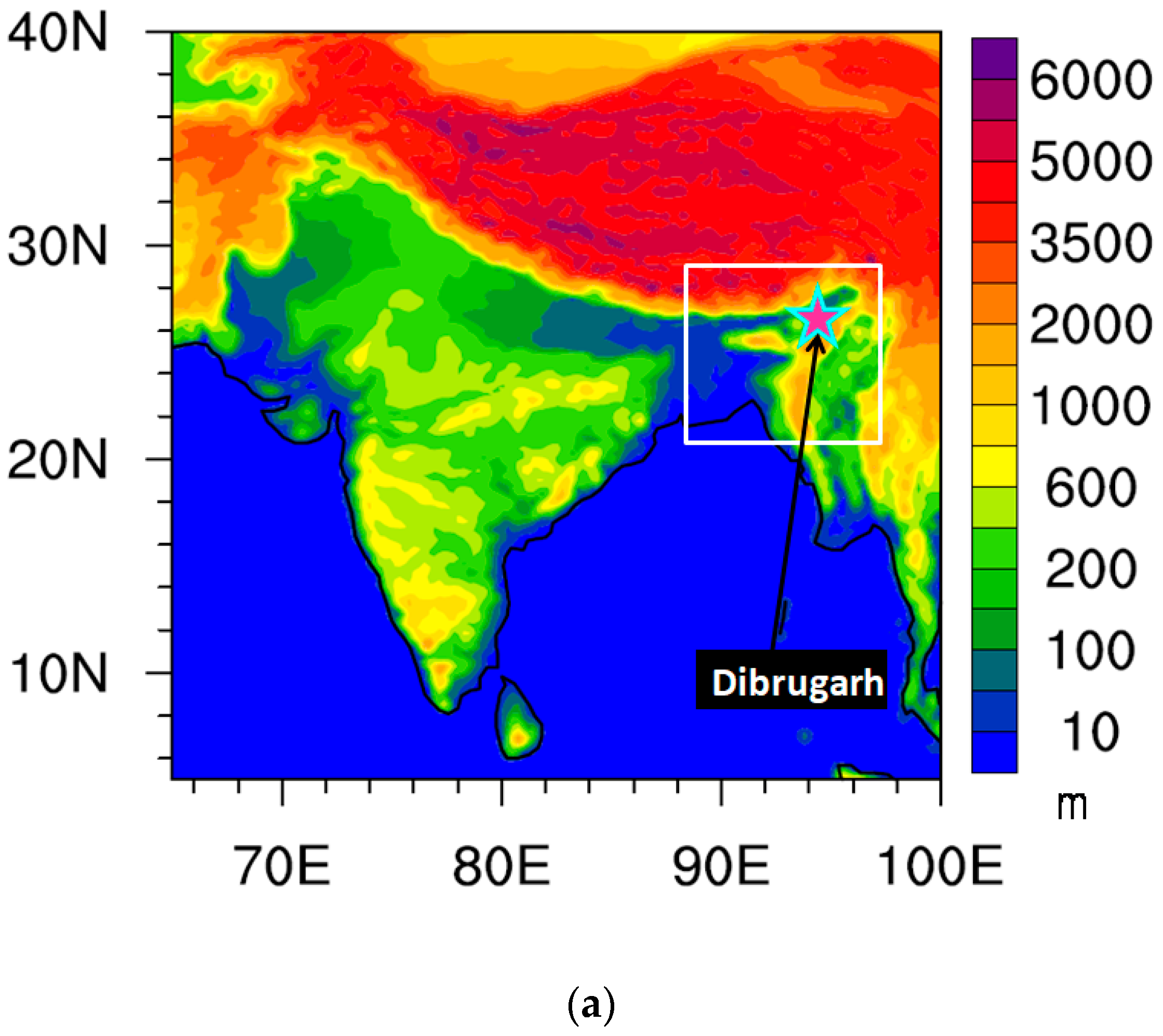

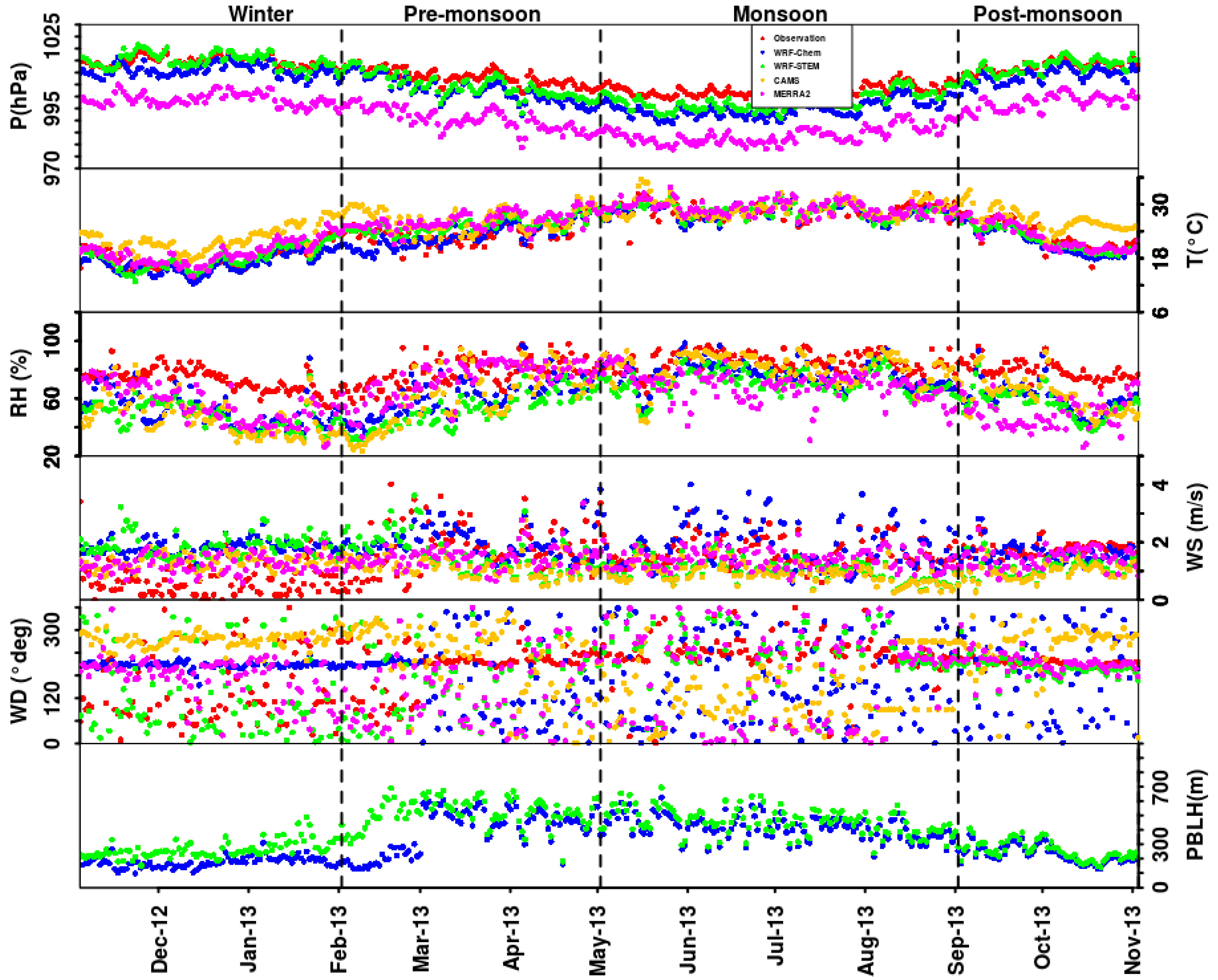
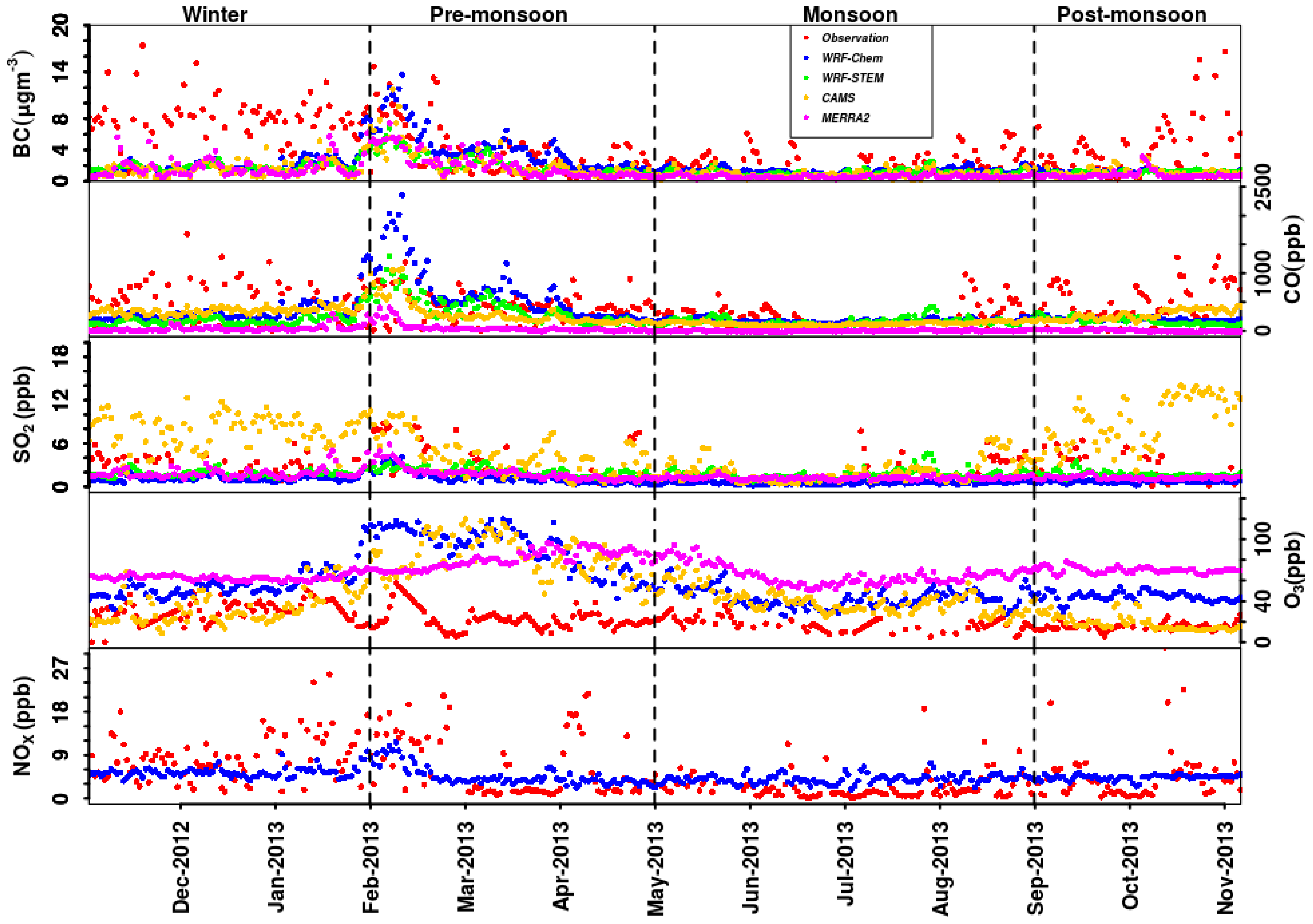
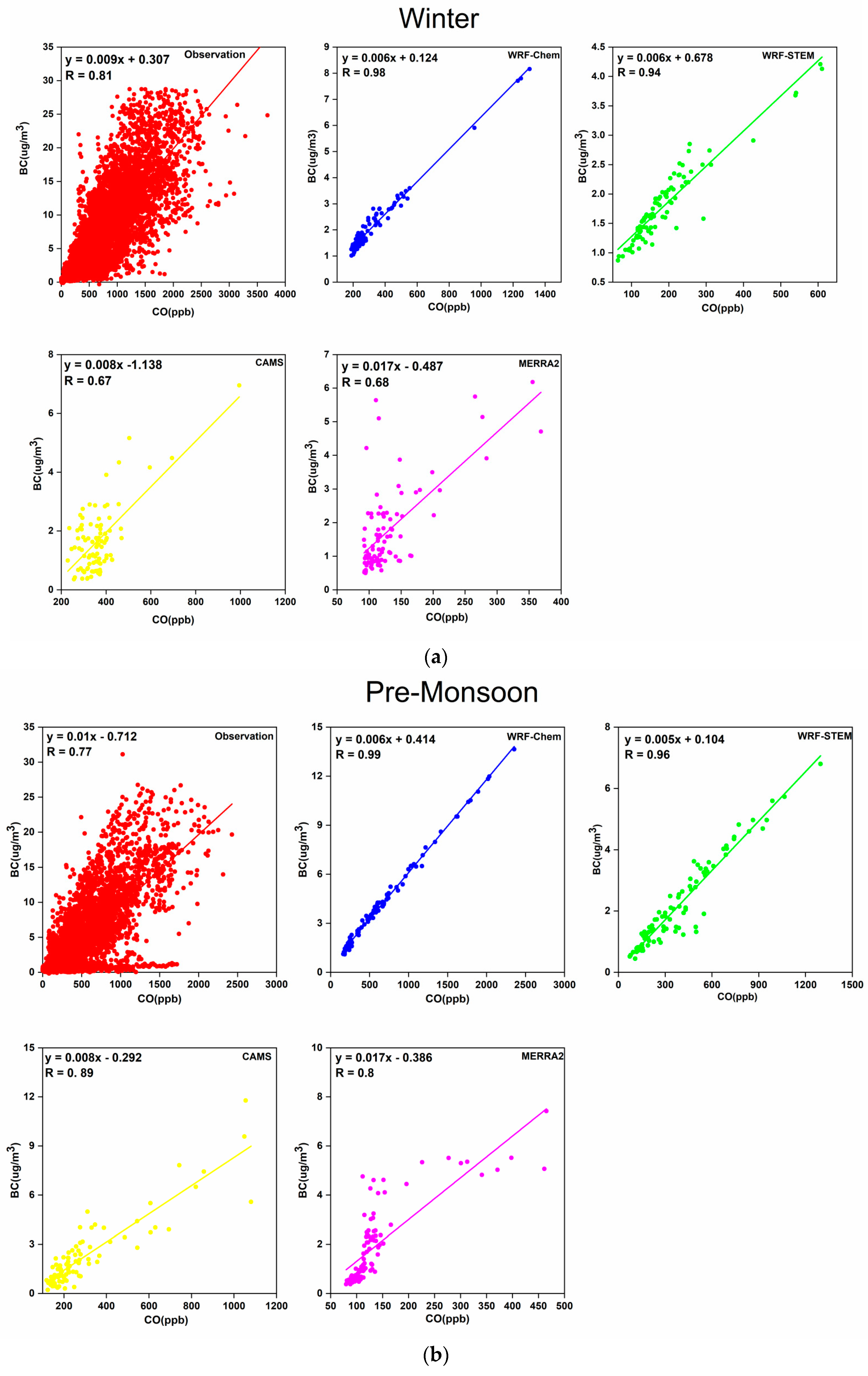
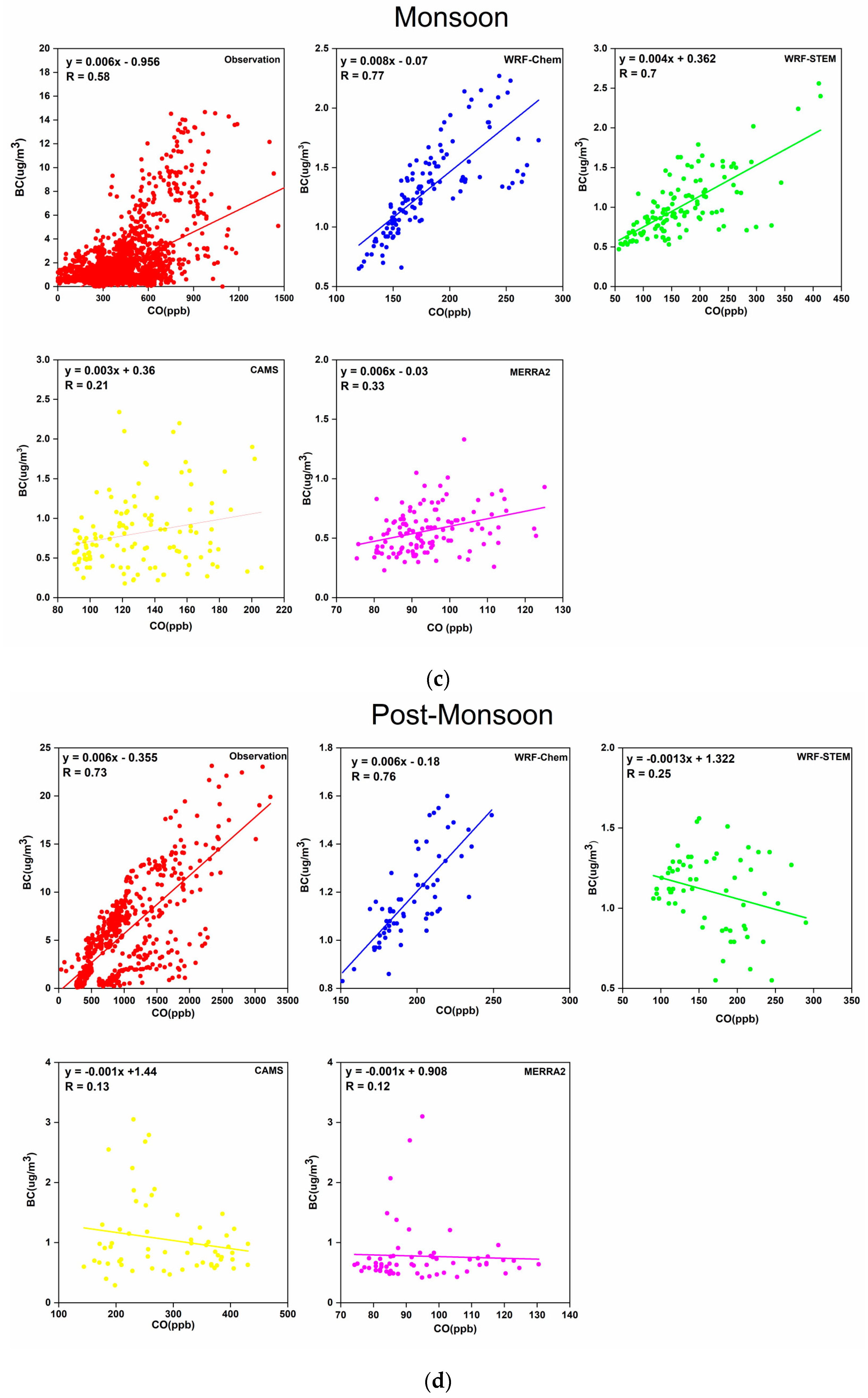

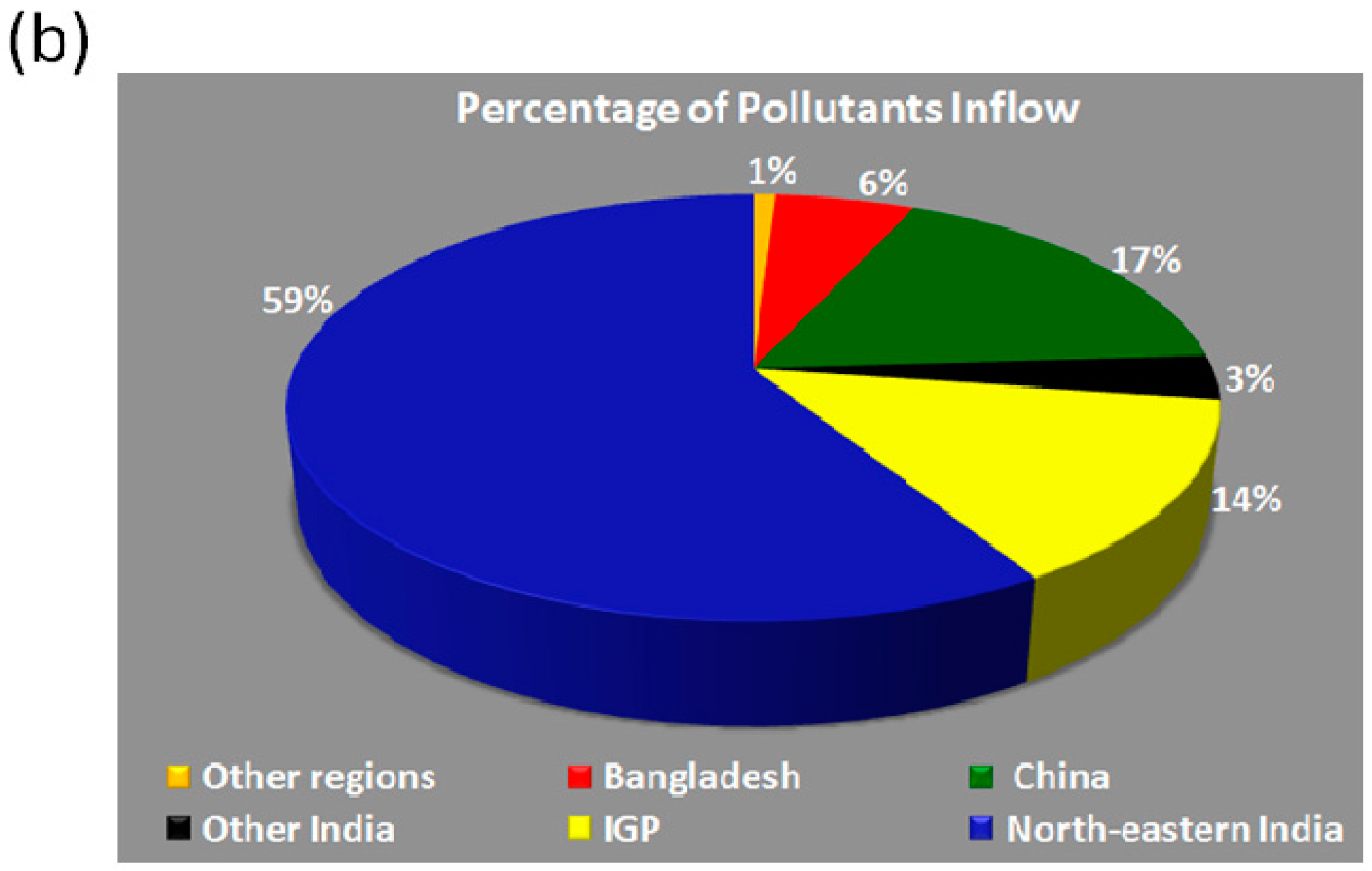

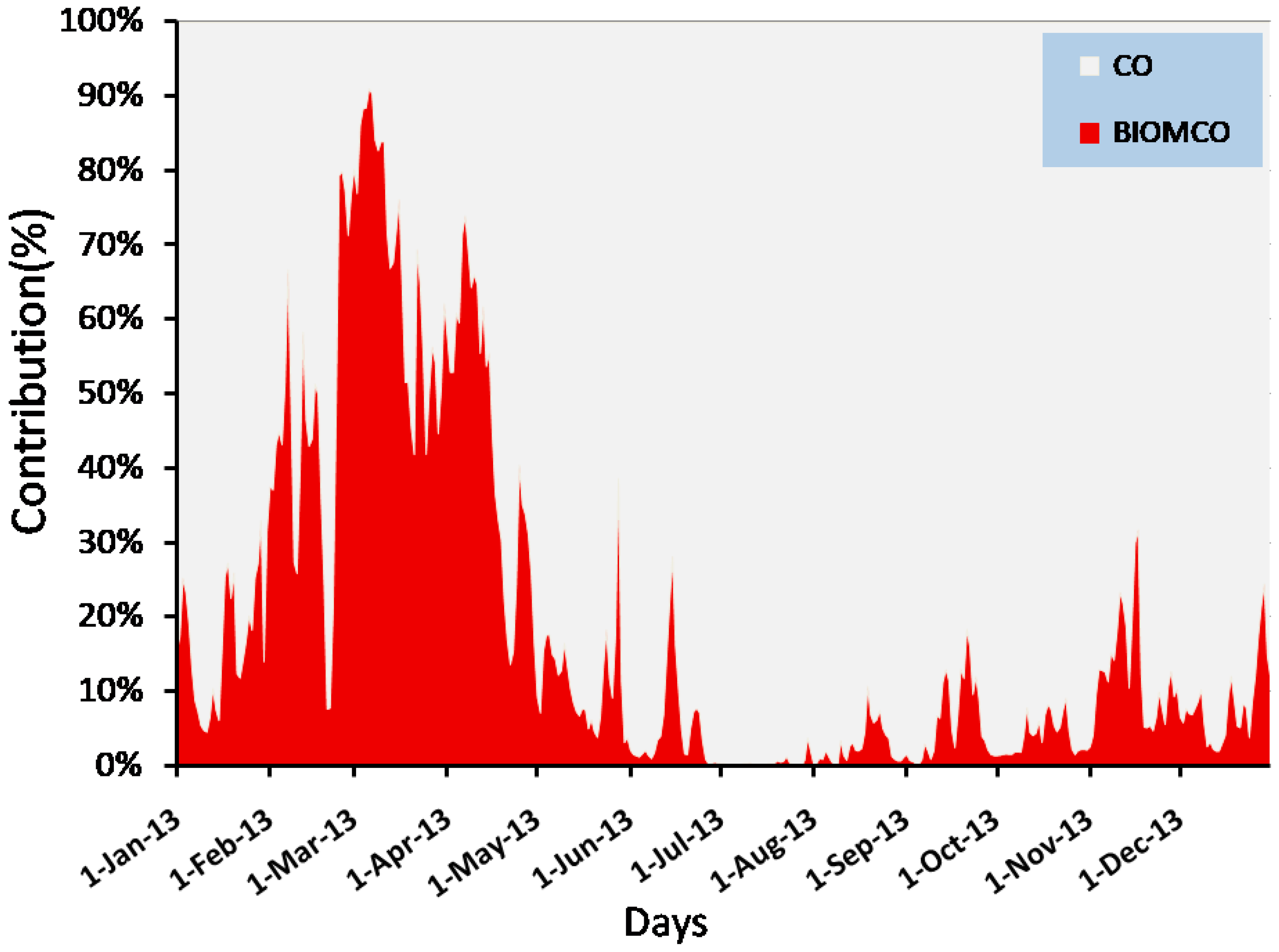
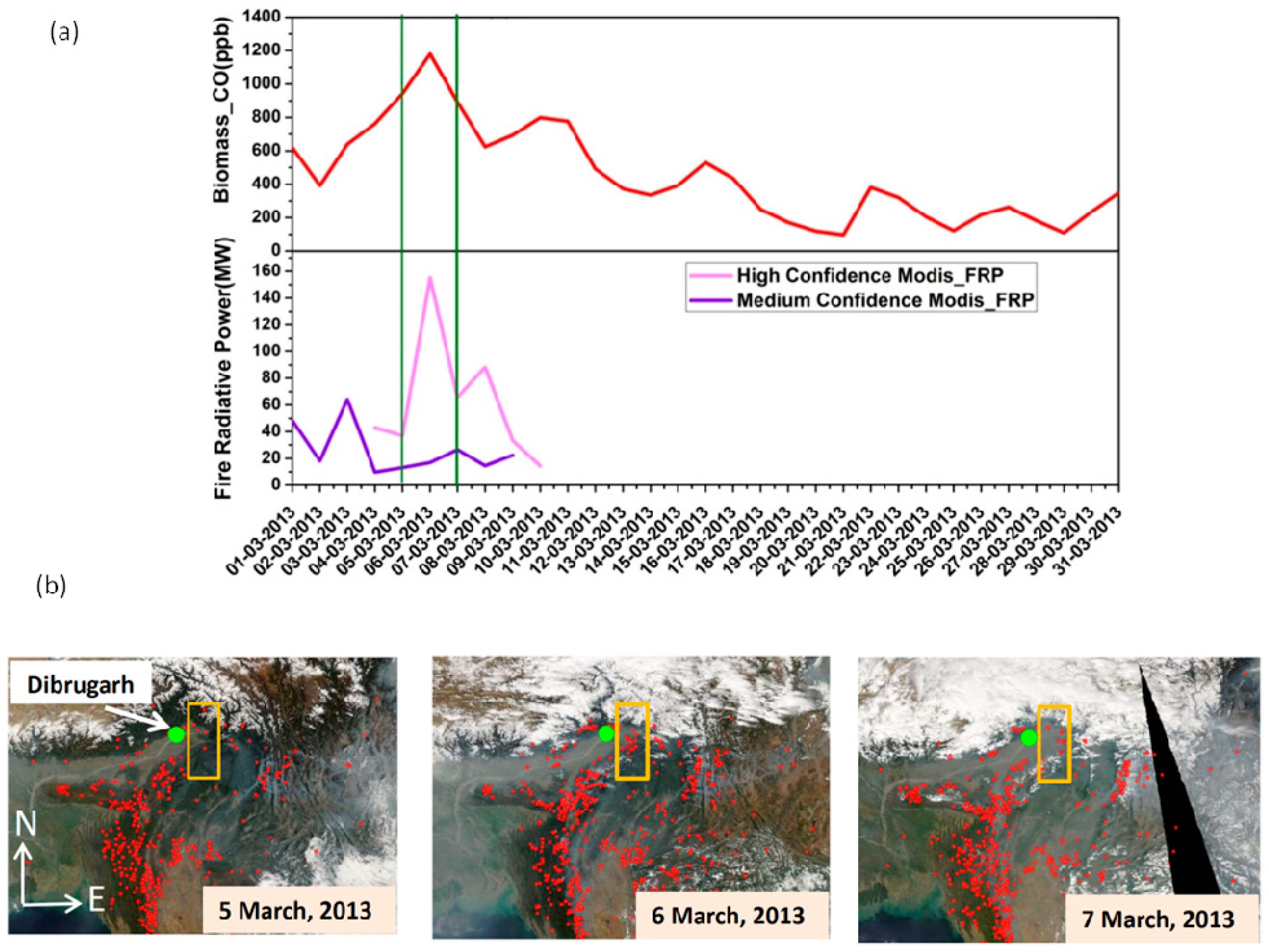
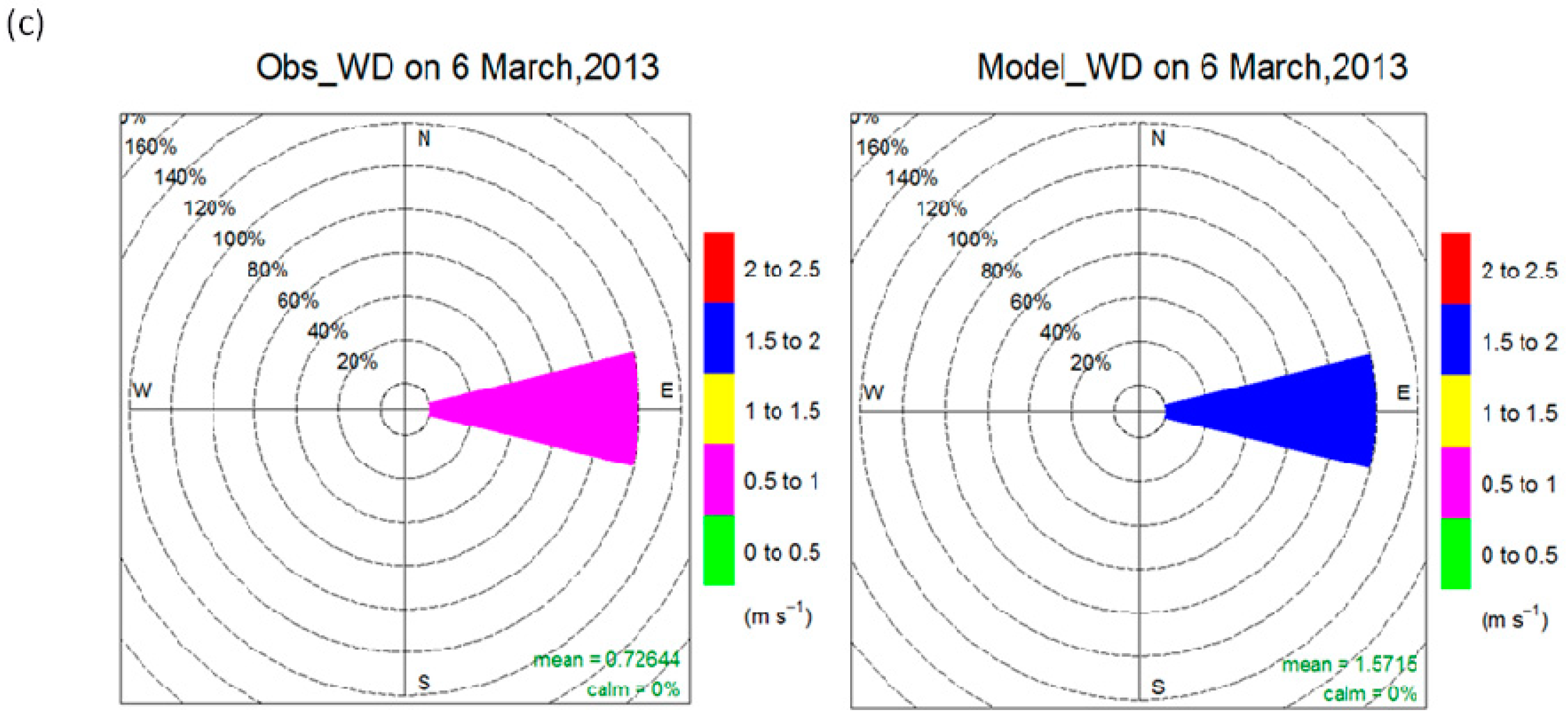
| Parameterization | Scheme | Reference |
|---|---|---|
| Bulk microphysical parameterization | Thompson scheme | [51] |
| Convective parameterization | Kain–Fritsch Scheme | [52] |
| Planetary boundary layer (PBL) | Yonsei University Scheme | [53] |
| Shortwave radiation physics | Dudhia Shortwave Scheme | [54] |
| Longwave radiation physics | RRTM Longwave Scheme | [55] |
| Photolysis | Madronich fast-Ultraviolet-Visible Model (F-TUV) | [56] |
| Temporal Scale | Statistics | Pressure (hPa) | Temperature (°C) | RH (%) | WS (m/s) | |||||||||||
|---|---|---|---|---|---|---|---|---|---|---|---|---|---|---|---|---|
| Observation vs Models/Reanalysis | WRF-Chem | WRF-STEM | MERRA2 | WRF-Chem | WRF-STEM | CAMS | MERRA2 | WRF-Chem | WRF-STEM | CAMS | MERRA2 | WRF-Chem | WRF-STEM | CAMS | MERRA2 | |
| Annual | Mean_obs | 1008.61 | 1008.55 | 1008.61 | 23.86 | 23.9 | 23.85 | 23.86 | 81.17 | 81.16 | 80.76 | 80.79 | 1.35 | 1.35 | 1.36 | 1.35 |
| Mean_Model/Reanalysis | 994.77 | 997.14 | 986.08 | 23.07 | 24.08 | 26.31 | 24.9 | 63.72 | 57.98 | 64.06 | 62.97 | 1.84 | 1.81 | 1.08 | 1.38 | |
| Bias | 13.84 | 11.42 | 22.52 | 0.79 | −0.18 | −2.47 | −1.04 | 17.46 | 23.18 | 16.69 | 17.82 | −0.48 | −0.45 | 0.27 | −0.03 | |
| Normalized mean bias | 0.01 | 0.01 | 0.02 | 0.03 | −0.01 | −0.1 | −0.04 | −1.24 | −0.95 | −1.62 | −1.17 | −0.36 | −0.34 | 0.2 | −0.02 | |
| MAE | 13.84 | 11.42 | 22.52 | 1.45 | 1.29 | 2.75 | 1.58 | 17.68 | 23.18 | 17.46 | 19.23 | 0.85 | 0.81 | 0.85 | 0.71 | |
| RMSE | 13.89 | 11.48 | 22.55 | 1.81 | 1.71 | 3.36 | 2.1 | 25.68 | 29.7 | 25.26 | 26.84 | 1.01 | 0.97 | 1.03 | 0.86 | |
| Correlation Coefficient | 0.98 | 0.98 | 0.98 | 0.94 | 0.93 | 0.89 | 0.92 | 0.4 | 0.4 | 0.46 | 0.23 | 0.37 | 0.45 | 0.29 | 0.39 | |
| Winter | Mean bias | 14.25 | 11.14 | 23.47 | 1.14 | 0.33 | −0.15 | −1.25 | 21.74 | 26.03 | 1.24 | 17.62 | −1.21 | −1.03 | 0.02 | −0.62 |
| Pre-monsoon | 13.65 | 12.27 | 22.88 | 0.66 | −1.47 | −2.66 | −2.46 | 16.62 | 26.13 | 16.55 | 5.66 | −0.15 | −0.18 | 0.71 | 0.38 | |
| Monsoon | 13.99 | 11.53 | 22.10 | 0.32 | 0.16 | −0.27 | −0.49 | 12.29 | 17.29 | 8.76 | 20.09 | −0.10 | −0.10 | 0.80 | 0.33 | |
| Post-monsoon | 13.46 | 10.54 | 21.83 | 1.44 | 0.89 | −3.51 | 0.31 | 20.80 | 24.59 | 19.40 | 32.21 | −0.70 | −0.70 | −0.07 | −0.52 | |
| Winter | Correlation coefficient | 0.64 | 0.93 | 0.65 | 0.87 | 0.88 | −0.20 | 0.88 | 0.50 | 0.71 | 0.05 | 0.59 | 0.06 | 0.35 | 0.82 | 0.12 |
| Pre-monsoon | 0.96 | 0.95 | 0.98 | 0.71 | 0.75 | 0.73 | 0.66 | 0.78 | 0.74 | 0.82 | 0.56 | 0.42 | 0.44 | 0.21 | 0.44 | |
| Monsoon | 0.94 | 0.92 | 0.94 | 0.59 | 0.55 | 0.66 | 0.57 | 0.29 | 0.22 | 0.26 | 0.08 | 0.47 | 0.47 | 0.28 | 0.49 | |
| Post-monsoon | 0.97 | 0.97 | 0.98 | 0.92 | 0.92 | 0.74 | 0.92 | 0.17 | 0.10 | 0.18 | -0.05 | 0.39 | 0.39 | −0.16 | 0.09 | |
| Statistics | CO (ppb) | BC (ug/m3) | SO2 (ppb) | O3 (ppb) | NOx (ppb) | |||||||||||
|---|---|---|---|---|---|---|---|---|---|---|---|---|---|---|---|---|
| Observation vs Models/Reanalysis | WRF-Chem | WRF-STEM | CAMS | MERRA2 | WRF-Chem | WRF-STEM | CAMS | MERRA2 | WRF-Chem | WRF-STEM | CAMS | MERRA2 | WRF-Chem | CAMS | MERRA2 | WRF-Chem |
| Mean_observation | 423.61 | 423.61 | 423.61 | 423.61 | 4.24 | 4.24 | 4.24 | 4.24 | 3.42 | 3.42 | 3.42 | 3.42 | 22.08 | 22.08 | 22.08 | 5.67 |
| 370.43 | 237.8 | 273.34 | 116.31 | 2.31 | 1.56 | 1.45 | 1.3 | 0.97 | 1.9 | 6.06 | 1.63 | 61.2 | 46.7 | 70.54 | 4.63 | |
| Mean_Model/Reanalysis | ||||||||||||||||
| Bias | 53.17 | 185.81 | 150.27 | 307.3 | 1.93 | 2.68 | 2.79 | 2.94 | 2.45 | 1.52 | −2.64 | 1.79 | −39.12 | −24.61 | −48.46 | 1.04 |
| Normalized mean bias | 0.13 | 0.44 | 0.36 | 0.73 | 0.46 | 0.63 | 0.66 | 0.69 | 0.72 | 0.45 | −0.77 | 0.52 | −1.77 | −1.12 | −2.19 | 0.22 |
| MAE | 325.03 | 293.2 | 274.12 | 338.21 | 2.87 | 3 | 3.11 | 3.2 | 2.53 | 1.96 | 3.49 | 2.08 | 39.13 | 27.69 | 48.46 | 3.96 |
| RMSE | 451.43 | 394.23 | 342.82 | 431.81 | 4.21 | 4.36 | 4.53 | 4.56 | 3.14 | 2.52 | 4.68 | 2.65 | 45.73 | 37.86 | 50.6 | 6.13 |
| Seasons | Observed BC-CO Correlation (R) | |
|---|---|---|
| 5-Minutee | Daily | |
| Winter | 0.81 | 0.7 |
| Pre-Monsoon | 0.77 | 0.5 |
| Monsoon | 0.58 | 0.17 |
| Post-Monsoon | 0.73 | 0.54 |
© 2019 by the authors. Licensee MDPI, Basel, Switzerland. This article is an open access article distributed under the terms and conditions of the Creative Commons Attribution (CC BY) license (http://creativecommons.org/licenses/by/4.0/).
Share and Cite
Saikia, A.; Pathak, B.; Singh, P.; Bhuyan, P.K.; Adhikary, B. Multi-Model Evaluation of Meteorological Drivers, Air Pollutants and Quantification of Emission Sources over the Upper Brahmaputra Basin. Atmosphere 2019, 10, 703. https://doi.org/10.3390/atmos10110703
Saikia A, Pathak B, Singh P, Bhuyan PK, Adhikary B. Multi-Model Evaluation of Meteorological Drivers, Air Pollutants and Quantification of Emission Sources over the Upper Brahmaputra Basin. Atmosphere. 2019; 10(11):703. https://doi.org/10.3390/atmos10110703
Chicago/Turabian StyleSaikia, Arshini, Binita Pathak, Prashant Singh, Pradip Kumar Bhuyan, and Bhupesh Adhikary. 2019. "Multi-Model Evaluation of Meteorological Drivers, Air Pollutants and Quantification of Emission Sources over the Upper Brahmaputra Basin" Atmosphere 10, no. 11: 703. https://doi.org/10.3390/atmos10110703
APA StyleSaikia, A., Pathak, B., Singh, P., Bhuyan, P. K., & Adhikary, B. (2019). Multi-Model Evaluation of Meteorological Drivers, Air Pollutants and Quantification of Emission Sources over the Upper Brahmaputra Basin. Atmosphere, 10(11), 703. https://doi.org/10.3390/atmos10110703





